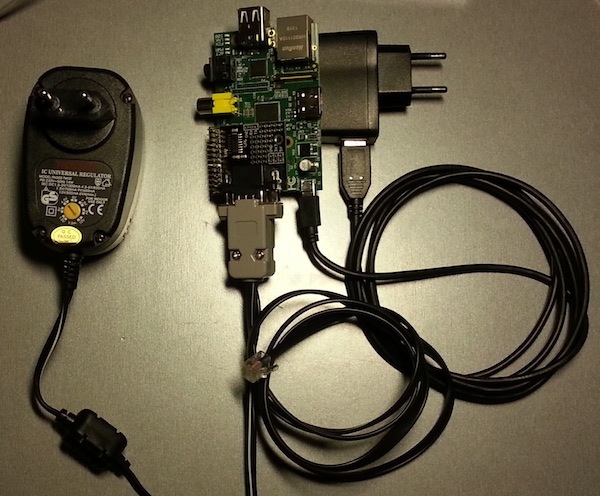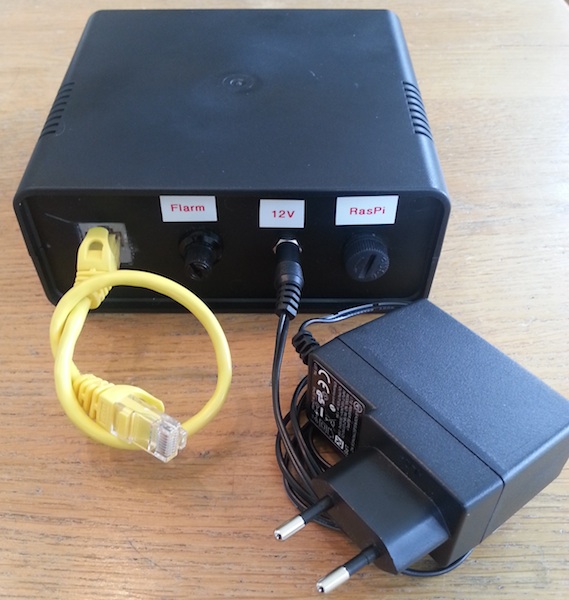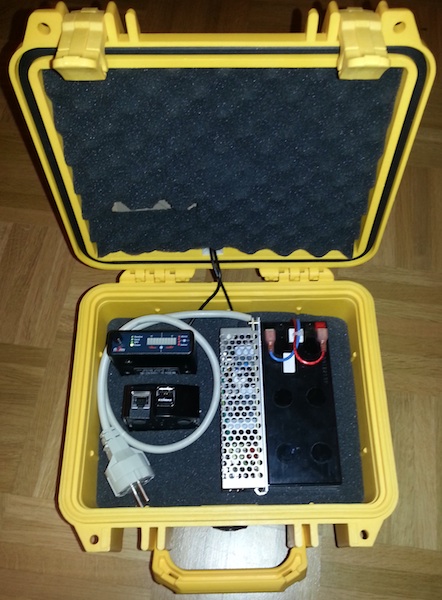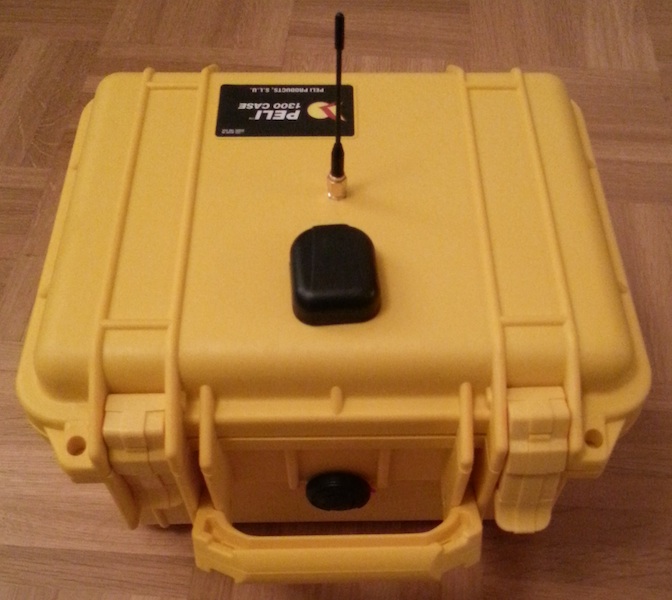| Version 33 (modified by , 12 years ago) (diff) |
|---|
This page is a collection of different approaches to realize a Flarmradar Ground Station. If you want to get your ground station up and running as quick as possible, then your should first read the Groundstation Construction Guide which describes the most convenient setup.
Advanced Groundstation Construction Guide


 Following types of Groundstations were already realized:
Following types of Groundstations were already realized:
- Minimalistic setup
- Indoor setup
- Outdoor setup
In the following paragraphs ideas and considerations for building your own ground station will be described in detail.
Infrastructure & Assembly
We used the following components to build up our client infrastructure. Note that links provided are just proposals for your convenience, other components will also work. Depending on your specific needs, there are several different methods to build and use your flarmradar groundstation. For all cases you need:
- a FLARM device
- a Raspberry PI
All revisions of the Pi can be used for Flarmradar ground stations. Depending on the revision you choose to use, wiring instructions differ slightly. We recommend a Raspberry Type B. You can purchase an SD card with the Pi's operating system pre-installed. For Pi+SD card see here.
For initial OS setup of your Pi, you will need a USB keyboard (mouse is optional but helps) and a screen which connects to Chinch-video signal or HDMI. Once your Pi is connected to the network, you can disconnect keyboard and screen and access it remotely via SSH.
- a Power supply
Depending on your specific requirements, creativity, etc. there are a lot of different ways to supply your Flarmradar ground station with power. We gathered experience with a few ways and will describe the different setups below. Flarm devices typically run on 12VDV power supply. All Raspberry Pi run on 5VDC. Hence you will have to generate and supply two different voltages within your ground station. Use a Micro-USB connector (e.g. RS-Online) to feed the power into your Pi.
- Power supply from grid available
- Use an external Flarm power converter (e.g. update cable) and a standard cell phone charger to supply 12VDC and 5VDC. Schematic. This setup is the minimalistic Setup, which will work perfectly for first trails or fixed installations.
- Use one standard external power converter (e.g. RS-Online) which supplies 12VDC and use a DC/DC converter (e.g. XXX) within the Flarmradar Ground station to convert 12VDC to 5VDC for the Pi. See Schematic. This is the indoor Setup I Setup II.
- Use an internal power converter, which can supply 12VDC and 5VDC. See Schematic
- NO Power supply from grid available = battery power
- Use a 12V battery (e.g. RS-Online) to power your Flarm and use a DC/DC converter (e.g. 2 x MEE3S1205SC in parralel OR 1x TEN 6-2411WIN-HI) to power your Pi. Make sure you buy a DC/DC converter with high efficiency so you don't drain your battery too fast.
- All in one power supply: The Mean Well power converter ADD-55A offers 12V and 5V power output which can be run on standard power supply (88-264VAC) when available. If no power line is availble the device features a battery charger to which you will have to attach a 12V backup battery (e.g. RS-Online). This battery will power the groundstation when disconnected from power grid. See Schematic
- A Flarmradar Groundstation using the Mean Well power converter and backup battery all installed in a roughed Peli Case can be seen in the two pictues to the right.


General hints for electrical wiring:
- An overview of the wiring can be found here: Wiring layout
- To connect the FGS to external power supply or battery, use a connectors, which are protected against polarity reversal.
- To protect your Flarm against over current, a 500mA fuse should be installed in the power supply route to the Flarm (e.g. RS-Online)
- Wiring instructions: 12V DC In --> Flarm fuse --> RJ45 connector --> network cable --> Flarm
- To connect your Flarm to the FGS, we recommend installing a RJ45 connector on the Flarmradar Groundstation front panel and to use a short network cable to connect the FGS to the Flarm
- For pin assignment of the RJ45-connector on Flarm, please consult Flarm Installation Manual
- To protect your Pi against over current, a 1A fuse should be installed in the power supply route to the Pi (e.g. RS-Online)
- Wiring instructions: 12V DC IN --> Pi Fuse --> DC/DC converter --> Micro-USB connector --> Pi
- Powering your Pi over the GPIO pins is not recommended. Reasons see here
- Flarm <--> Pi Data connection
- Flarm delivers RS232 signal on its data port. To feed this signal into the Pi, there are presently two alternative ways of doing:
- RS232-USB-cable
- Buy a RS232 to USB converter cable. Preferable one which uses the FTDI chipset. If you use a different chipset, this may not be supported by default by the Pi operating system.
- Attach the converter to your Flarm and to one of the USB connectors on the Pi
- Serial-In of the Pi (depreciated since complicated and possibly unreliable)
- The Pi features a serial interface (UART) on its GPIO pins.
- Pi's serial interface works on 3.3V. Hower, Flarm supplies higher signal levels. DO NOT CONNECT THE FLARM DATA LINES DIRECTLY TO THE PI'S GPIO PINS!!!
- Buy a RS232 to TTL level shifter (e.g. E-Bay - costs less than 2 EUR)
- Solder Flarm's TX, RX and ground (coming from the RJ45 jack) onto the RS232 side of the level shifter. Most level shifters have well labeled soldering pads
- Solder 4 wires to the TTL side of the level shifter. Ground, +3.3V, TX and RX need to be connected
- Buy a 2x13 IDC connector which attaches to the Pi's GPIO pin headers (e.g. RS-Online)
- Connect the four wires coming from the TTL side of the level shifter to the IDC connector. Pin layout depends on the version of your Pi. See GPIO Pins. If you have a revision 2 Pi, this is the pin connection: Pin1=+3.3V, Pin6=GND, Pin8=TX, Pin9=RX.
- Disable console output and boot messages on the serial interface. See here
- Alternatively, use the Raspberry's GPIO and a RS232-Adapter (e.g this one).
- use a micro usb plug, cut the cable to fit the length, remove the cable coating 3 cm before the open end. Since this cable serves just for power supply, we just use the red (+5V) and the black (GND) cable, cut the remaining two other away
- cut 3 cables to length, red (12V), black (GND) and a third color (5V)
- cut the RJ45 cable to length, remove the cable coating 3 cm before the open end, cut away the cables for RJ45-Pin's 2,3
- connect RJ45-Pin5 (usually blue) with Pin 2 of a Female Sub-D plug
- connect RJ45-Pin6 (usually white-green) with Pin3 of a Female Sub-D plug
- connect RJ45-Pin8 with Pin5 of a Female Sub-D plug
- solder RJ45-Pin's 4,7 with the black cable of the micro USB plug and the other black cable (GND)
- solder RJ45-Pin1 with the red cable (12V)
- solder the third coloured cable (5V) with the red cable from the micro usb plug
- Pi <--> Internet - data connection
- If you have Lan network available at the location where you will setup your ground station, you can connect it directly to the Pi. It comes with a lan network connector.
- If you have Wifi network available at the location where you will setup your ground station, you will have to buy a USB-Wifi connector. This Wifi-connector was tested by us with the Pi and works out of the box.
- optional, recommended for a stationary installation: we use currently an external antenna
Shopping list
To build your own Wifi enabled Flarmradar ground station which runs on 12VDC external power following items are required:
| Raspberry Pi Type B with SD card | Link | 34,80 € |
| IDC-socket 2,54mm 2x13 pins | Link | 3,82€ |
| External power supply 12V 1A 12W | Link | 14,29 € |
| Fuse socket | Link | 4,19 € |
| DC/DC-converter 9-36Vin 5Vout 1,2A 6W | Link | 23,20 € |
| micro-USB cable | Link | 3,43 € |
| 500mA Fuse for Flarm | Link | 1,88€ |
| 1A Fuse for Pi | Link | 1,34€ |
| Edimax Wireless Nano USB-Adapter | Link | 11,00 € |
| RS232 to TTL converter | Ebay | ~ 2 € |
| DC female connector | Link | 8,77 € |
| Network patch cable | Link | 1,39 € |
| RJ45 female connector | Link | 2,06 € |
| Case | <10,00 € | |
| Spare wires | depends | |
| Heat Shrink tube | depends | |
Knowledge & Troubleshooting
- Raspberry PI specific issues are collected on a separate page
Attachments (17)
-
Flarmradar_GS5.png (81.2 KB) - added by 12 years ago.
Two individual power supplies
-
Flarmradar_GS4.png (80.4 KB) - added by 12 years ago.
12VDC and DCDC converter
-
Flarmradar_GS3.png (80.5 KB) - added by 12 years ago.
ACDC converter with two voltages
-
Flarmradar_GS2.png (84.4 KB) - added by 12 years ago.
ACDC converter with backup battery
-
Flarmradar_GS_overview.jpg (191.7 KB) - added by 12 years ago.
Overview of Flarm radar ground station
- Flarmradar_GS_overview2.jpg (118.0 KB) - added by 12 years ago.
- Flarmradar_GS_peli1.jpg (157.3 KB) - added by 12 years ago.
- Flarmradar_GS_peli2.jpg (191.8 KB) - added by 12 years ago.
- Flarmradar_GS_peli2.2.jpg (219.2 KB) - added by 12 years ago.
-
Flarmradar_GS_wiring.jpg (211.5 KB) - added by 12 years ago.
Wiring description
-
Pi_Converter_Cables.png (98.4 KB) - added by 12 years ago.
Pi with RS232 converter and cables
- Flarmradar_GS.jpg (18.3 KB) - added by 12 years ago.
- Pi_RS232_Converter.jpg (18.4 KB) - added by 12 years ago.
-
Pi_RS232_Cables.jpg (112.6 KB) - added by 12 years ago.
Pi with RS232 converter and cables
-
indoor_GS.jpg (102.3 KB) - added by 12 years ago.
Indoor Ground Station
-
PeliFlarm1.jpg (100.4 KB) - added by 12 years ago.
Groundstation in Peli Case
-
PeliFlarm2.jpg (106.4 KB) - added by 12 years ago.
Groundstation in Peli Case
Download all attachments as: .zip
![(please configure the [header_logo] section in trac.ini)](/trac/flarmradar/chrome/site/your_project_logo.png)